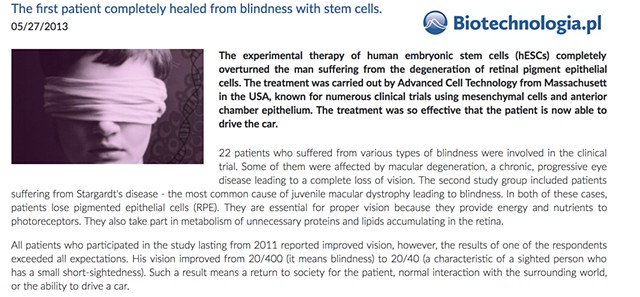Art appropriation
The experimental therapy of human embryonic stem cells (hESCs) completely overturned the man suffering from the degeneration of retinal pigment epithelial cells. The treatment was carried out by Advanced Cell Technology from Massachusett in the USA, known for numerous clinical trials using mesenchymal cells and anterior chamber epithelium. The treatment was so effective that the patient is now able to drive the car.
22 patients who suffered from various types of blindness were involved in the clinical trial. Some of them were affected by macular degeneration, a chronic, progressive eye disease leading to a complete loss of vision. The second study group included patients suffering from Stargardt's disease - the most common cause of juvenile macular dystrophy leading to blindness. In both of these cases, patients lose pigmented epithelial cells (RPE). They are essential for proper vision because they provide energy and nutrients to photoreceptors. They also take part in metabolism of unnecessary proteins and lipids accumulating in the retina.
All patients who participated in the study lasting from 2011 reported improved vision, however, the results of one of the respondents exceeded all expectations. His vision improved from 20/400 (it means blindness) to 20/40 (a characteristic of a sighted person who has a small short-sightedness). Such a result means a return to society for the patient, normal interaction with the surrounding world, or the ability to drive a car.
The treatment procedure that ACT scientists used was already known. Human embryonic stem cells were laboratory-converted to RPE and then injected under the pigmented epithelial layer in the affected eye. Cells of embryonic origin have been used, however recent successes in the field of stem cell cloning can mean the end of use of the germinal material. Researchers are also considering the use of stem cells of somatic origin as an alternative in the treatment of ocular degenerative diseases. Until now, clinical trials on restoring vision to people with retinal pigment epithelial degeneration did not result in spectacular results. Positive results of gene therapies used so far proved to be temporary,
It should be noted that the ACT tests are not over yet. The final publication will answer the question whether a procedure using stem cells is safe for humans. If the results are satisfactory, we can expect the popularization of this simple in the therapy application. This opens the way for other researchers investigating the use of hES cells. Advanced Cell Technology has implemented something that other companies have not yet been able to achieve.
